Best portable power stations UK 2023: prepare for power outages with generators from Anker, EcoFlow, Jackery
This article contains affiliate links. We may earn a small commission on items purchased through this article, but that does not affect our editorial judgement.
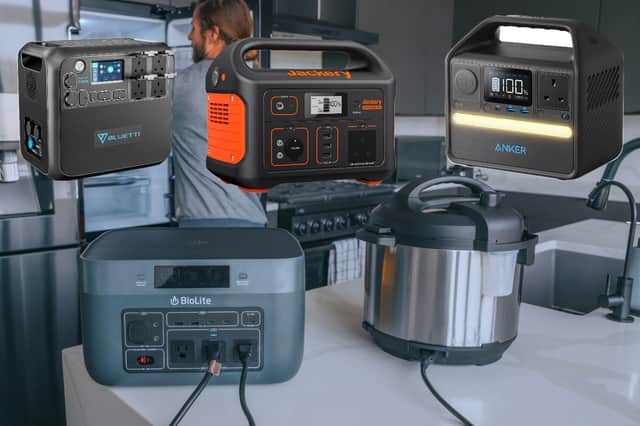

Although the technology is still in its infancy and therefore much more expensive to buy than most petrol-powered generators, portable power stations are an excellent way to beat the spectre of power cuts and a handy addition to anyone’s household armoury. They are emission free while in use, can be safely used indoors and will provide a source of power to many household devices, including stand-mounted lights, internet hubs and routers, desktop and laptop computers and most smart TVs. The essentials, in other words.
Best portable power stations at a glance
- Best for features and usability: BioLite BaseCharge 600
- Best for value: Anker 521 PowerHouse
- Best for versatility: EcoFlow DELTA Mini
- Best for high power output: BLUETTI Portable Power Station
- Best for price vs power output: Jackery Explorer 500
What is a portable power station?
The portable power station (or solar generator as it’s known in the States) is essentially an offshoot of the humble pocket-sized USB power bank that we all use to charge or power our phones when away from a mains power source.
However, where pocket power banks can only produce enough wattage to charge a phone or tablet, a power station has a much larger and therefore more powerful lithium-ion battery capable of providing power to a wide range of household appliances that normally run on a 240v mains supply. Aside from providing ancillary power during a mains power cut, they are also a brilliant addition to anyone’s camping, caravanning and boating paraphernalia.
Most portable power stations are equipped with a wide range of power outlets including multiple AC 240-volt outputs plus USB-C, USB-A and car-style 12v DC ports. This means they can provide juice to a huge variety of devices – from home lighting and TVs to laptops, tablets and phones – and often at the same time. And because everything is monitored in real time, you can see exactly how much power is being drawn by any given appliance or device by simply looking at the respective model’s LCD info screen.
How to choose a portable power station
Portable power stations are battery-powered and can therefore be used safely both indoors and outdoors. By their very nature, power stations are quite large though not necessarily as big and heavy as you may suspect. On average, a mid-level 882 watt hour model from one of the market leaders EcoFlow measures 37cm in width and about 23cm in height.
However, it does weigh approximately 11kgs. This weight is of no consequence if used at home but you won’t be able to pack it in your backpack unless you’re built like a brick outhouse. Obviously, the more powerful the power station, the bigger and heavier it will be.
Power station prices rise in accordance with the amount of watt hours they provide so if on a budget, opt for a sub-600 watt-hour which will easily be powerful enough to keep most household essentials going in a power cut (more on that below). And if money’s no object, go for a larger 3,000w/h model which will provide enough electron oomph to power a kettle and other energy-intensive devices.
What is a watt hour?
Power station manufacturers use the term watt hours (w/h) to determine a model’s ability. In fact, your electricity company uses the same measurement when determining how much electricity you are using. In a nutshell, a watt-hour is the measurement of energy for a specific period of time (an hour), while a watt is a measurement of power at a moment in time. But all you need to know is that the higher the watt hour specs of a power station, the more likely it is to be able to power a wider variety of household appliances.
What kind of household appliances can a portable power station run?
You’d be surprised what a portable power station is capable of running. For instance, an average entry-level 1,000 watt hour model like the Bluetti EB70 will have sufficient clout to run the following individual devices, sometimes for several hours at a time: laptop or desktop computer, a 60-inch smart TV, home wifi, several standard lamps, coffee machine, pellet grill, mini fridge, a CPAC oxygenator for treating sleep apnea and, in some cases, a portable induction hob like the excellent 2.1kW Tefal Everyday Slim.
During a three-hour blackout it should be capable of giving you up to three hours of TV with a few low-voltage lights running or many hours on a laptop with full wifi. However, you will likely need to use an extension lead in some instances if appliances are some distance apart. Finally, you’re advised to top up the charge every six months if the power station isn’t being used. This is to help keep the battery in tip-top condition.
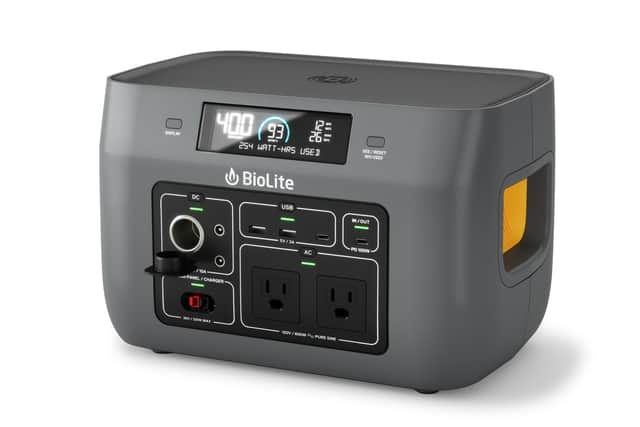

PROS
Excellent performance
Intuitive interface
Versatile functions
Low weight
CONS
Pre order only
BioLite is no stranger to battery charging banks – its CampStove 2+ will charge a mobile phone using the power of fire alone – but this is the New York-based company’s first foray into fully-blown power stations and the BaseCharge 600 bursts out of the blocks with an array of tantalising specs that compete very favourably with the competition.
The BaseCharge is available in two power configurations: a large 1,500Wh that will run a full-sized refrigerator for up to 20 hours and this smaller and more affordable 600Wh version we’re looking at here. A shade under £800 buys you a handsome block of tech-laden beauty replete with two 240v AC inputs with 1,000w surge for power-hungry devices, two USB-A ports, a further two USB-C outputs and three DC outlets. It also features a 10W wireless charger – simply place your wireless-enabled phone in the centre of the top plate.
According to the BaseCharge 600’s specs, it will run a 55-inch TV for an impressive six hours and provide up to nine laptop charges with zero fuss. And, like all power stations, you get dynamic realtime readouts on the intuitive crystal-clear LCD so you know exactly how much juice is being used and how much is left in its lithium-ion battery. Along with this, the BioLite is alone in providing a resettable energy odometer so you can monitor usage over longer periods of time.
The BaseCharge 600 will charge up to 80% in just 3.5 hours which is about as good as it gets. Moreover, if used in conjunction with BioLite’s solar panels, you’ll be able to enjoy endless power for as long as the sun shines.
At just 5.9kgs the BaseCharge 600 is arguably the lightest sub-700Wh model you can buy. It’s attractively designed, amazingly easy to use and well up there with the bigger players. Watch this space.
The BioLite BaseCharge 600 ships for free from November so get your order in now.
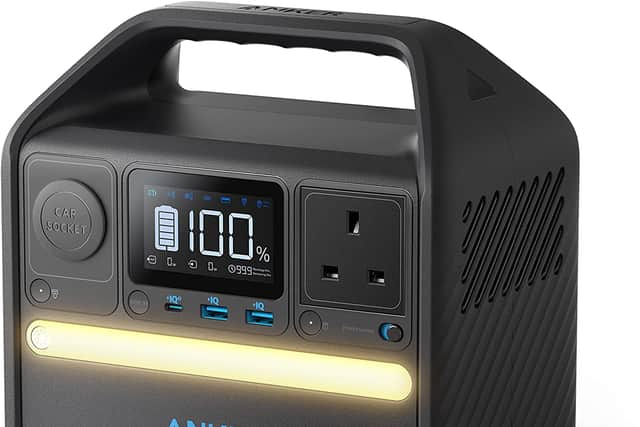

PROS
Great price
Lightweight
Compact size
CONS
Lower power specs
Anker is a reputable company that specialises in portable power devices, phone cables and desktop hubs. This lightweight model is among the cheapest on the market and is an ideal saviour in power-cut emergencies because it will easily run essential gear like a MacBook Air laptop, a full home wi-fi system and a couple of 12w lamps so you can continue to function while the rest of the neighbourhood fumbles about in candlelight.
The 521 PowerHouse has a modest 261Wh lithium-ion battery on board which charges up in about 2.5 hours via 11-28v DC and USB-C. It comes with a single AC 240v outlet, two USB-C ports, one USB-A port and a 12v car charger outlet – the essentials, in other words.
At just 21.6cm in length, 21.14cm in height and just 4.34kgs in weight, the Anker 521 PowerHouse is a perfect model for travel on foot and a little titan when it comes to camping and caravanning. Best budget buy.
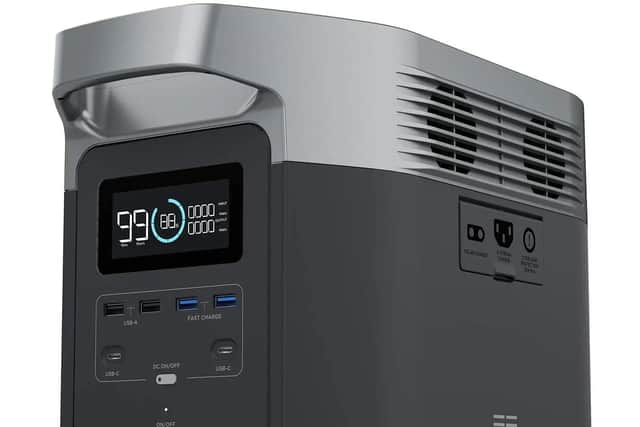

PROS
Decent power output
Fast charging
Wide range of outputs
CONS
Quite heavy
EcoFlow’s DELTA Mini is about all you need in a power station. At 882Wh, it’s not the most powerful model in the EcoFlow range and, at 11kgs, it’s not light, but it’s got some cracking specs. From an output point of view you get two 230v pure sine wave outlets, two 5v USB-A ports, a single 5-to-20v USB-C port and two 12.6V DC outputs.
Enough options, in other words, to power a wide range of devices and home appliances. Moreover, with X-Boost technology on board, the fast-charging DELTA Mini is capable of powering some hungrier devices like hair dryers and power tools up to 2200W. And if you pair it with the EcoFlow 220W Bifacial Solar Panel (£549) you’ll get even more life out of it.
We used this model on a canal boat recently and it performed superbly well, saving our bacon when the boat’s inverter ran out of juice because we’d failed to idle the engine to boost the boat’s main battery. It kept the onboard TV and a pair of LED lamps going, and charged two iPhones in short shrift. And that’s just what you want from a power station.
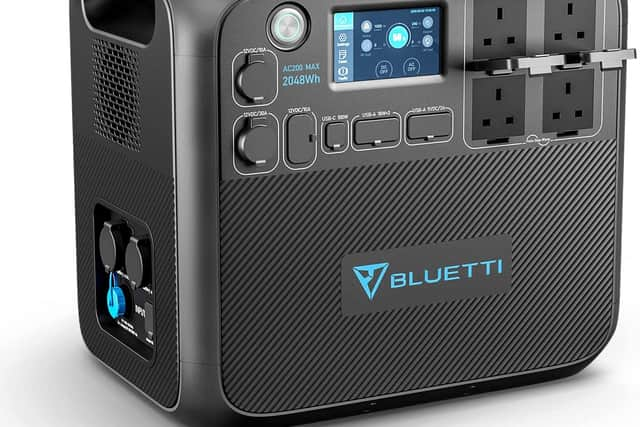

PROS
It will power most appliances
Excellent range of outputs and inputs
CONS
Extremely heavy
Bluetti is a major player in the pantheon of both portable power stations and larger semi-portable battery backup models for home use. The AC200Max features a 2,200-watt AC Pure Sine Wave Inverter with a 2,048Wh capacity.
However, it can be expanded up to a whopping 8,192Wh with two extra B300 batteries at an albeit scary cost of £2,199 - each! Like electric cars, power stations do not come cheap.
The AC200Max is extremely well endowed with seven recharging methods – AC, solar, car, petrol generator, lead acid battery, plus AC and AC+Solar – and a full gamut of outputs – four 240V ACs, four USB-Cs, one 12v RV outlet, one 12v car outlet and two 5.5mm DC 5521 outputs.
Enough outputs in other words to power every conceivable device or appliance. In fact, according to Bluetti, this super heavyweight beast will power a 1.65kW grill for one hour, a 1.2kW fridge for up to 28 hours, an 8,000BTU air conditioner for up to seven hours, a coffee machine for up to 70 cups and a 10-watt lightbulb for well over 50 hours. You could feasibly boil a kettle, too, but you’d be better off using a portable induction hob.
This model measures 42 x 28 x 38.65cm and weighs a significant 29.1 kgs so it’s definitely not something you can easily carry around. But for full peace of mind when/if a power cut occurs, you know you’ll be in good hands.
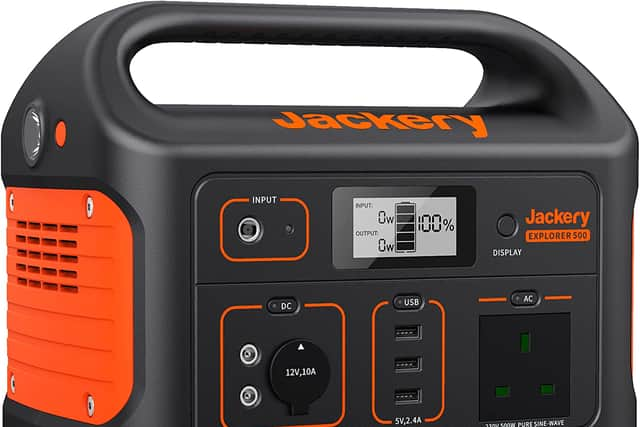

PROS
Good value
Excellent wattage
Light in the hand
CONS
No USB-C ports
Noisy fan
Red Dot Award-winner Jackery is a popular choice at Amazon and this model is a great option if you want maximum punch for minimum price.
The Explorer 500 ships with 518Wh of juice which equates to 7.5 hours of smart TV viewing, 38 hours of light and over four complete laptop charges. It will also power a mini fridge for up to eight hours. At 6kgs, it’s among the lightest on test and its integrated handle makes it easy to move it around the home or campsite.
From an output point of view, the Explorer 500 includes a 230v pure sine wave AC outlet with a 1,000w peak, two DC ports, a car port and three USB-A ports – sadly there are no USB-C outputs here which is a bit of an oversight. Also, some users say the sound of the onboard fan is quite annoying, especially when used in the home.
But on the plus side, thousands more have nothing but praise for the Explorer 500. They cite its ease of use, compact size and wherewithal to power up all outdoor devices and most indoor ones with zero fuss.
